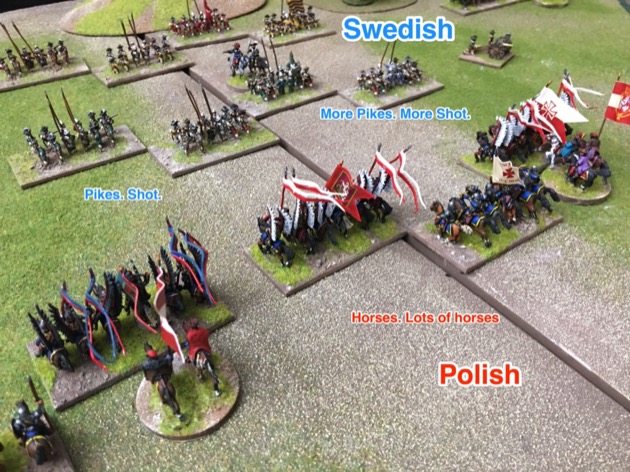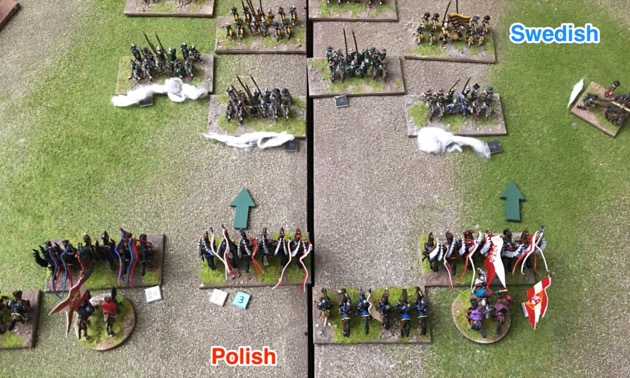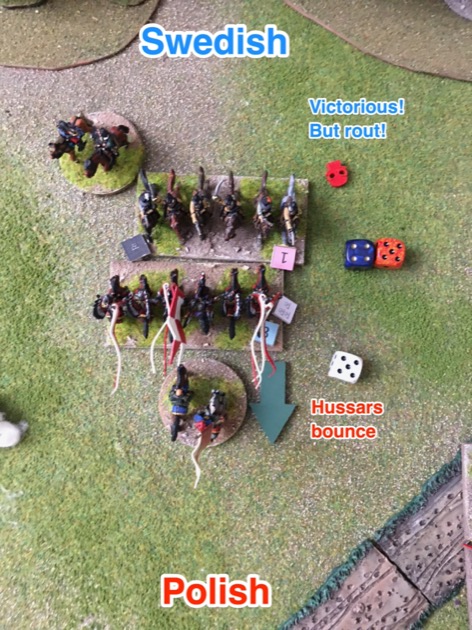I’m still keen on playing with my brand new Polish-Lithuanian Army so when Chris came over I suggested we play Small Kircholm. The scenario was very draft and I expected to find that it favoured the Poles too much. In particular the experimental Hussar rules were probably a touch too punchy. In Tilly’s Very Bad Day terms this is a small game on a small table with small armies.
Summary: Poles rolled over the Swedes in three game turns. Scenario needs tweaking. The experimental Lancers were a super troop type – and we don’t need that kind of thing.

Phase 1: Game Set up
1.1. Agree game size
Small game, with small armies, on a small table.
1.2. Recruit armies
The scenario gives the armies. After this game I changed the Polish-Lithuanian Commonwealth’s order of battle. So I include the one I used here.
Polish-Lithuanian Order of Battle
- Right Wing (4 Units; 18 Coins)
- 1 x Commander (Sapieha)
- 2 x Lancer Superior/Inferior [Hussars]2
- 1 x Horse [Pancerni Cossacks]
- Centre (6 Units; 24 Coins)
- 1 x Commander (Jan Karol Chodkiewicz)
- 2 x Lancer Superior/Inferior [Hussars]2
- 1 x Horse [Kurlander Arquebusiers]
- 1 x Shot
- 1 x Unlimbered Cannon1
- Left Wing (5 Units; 20 Coins2)
- 1 x Commander (Dabrowa)
- 2 x Lancer Superior/Inferior [Hussars]2
- 1 x Horse or Light Horse [Cossacks, German Arquebusiers] – I took the Horse option
- 1 x Light Horse [Tatars, Cossacks]
- 15 Units; 62 Coins; 5 break point
Nominal unit size: 300 for Lancers; 1000 for Pike+Shot, Shot, and Rabble; 500 for Horse, Dragoons and Light Horse; 8 guns for Cannon.
Lancers
This scenario was intended to play test Lancers as there was a good chance they will unbalance the game.
One of the options in my Musing on Polish Winged Hussars in Tilly’s Very Bad Day, was to have a new trop type for Tilly’s Very Bad Day, Lancers. They have all the characteristics of Horse, except:
- They roll 1d6 more when charging
- They cannot shoot, ever.
The genuine Polish Hussars are also Superior, so have a starting Resolve of 4. The dummy hussars are inferior and so have a starting Resolve of 2.
1.3. Determine attacker
The scenario specifies the Swedish as the attacker.
1.4. Place Terrain
The scenario specifies the terrain.

1.5. Scouting
My Tatars/Cossacks (Light Horse) gave me 2d6 Scouting. I got one hit and delayed, so Chris had to deploy a command before me.
1.6. Deployment
Both armies formed in a chequerboard.

Essentially the Swedes formed with the infantry forward and the cavalry wings withdrawn.

The Swedish infantry were organised into two echelons. The first echelon had the Swedish recruits (inferior) and the 3rd echelon, behind them, had the German mercenaries. This division impacted their deployment. Each echelon deployed in a chequerboard.

The Polish-Lithuanian Commonwealth had cavalry in a long line. There was only one unit of shot in the centre.

1.7. Bombardment
The guns roared but nothing meaningful resulted.
Turn 1
The Poles roared forward. I figured the game was to test the Lancer special rule so the sooner I got to charge the better.


On the right we had equal numbers. But the difference in quality was notable. Particularly as I was using little 1 cm x 1 cm markers to show which units were Inferior and which were Superior. Admittedly the Hussars didn’t need the markers … they had feathers.

The centre was going to be the real test for both of us. Chris’s pike and shot. My Hussars. Who was going to win?

The Swedish muskets roared, but I was unfazed. Particularly as one of his supporting units – the one with the commander – couldn’t fire because other Pike+Shot units were in the way.

Only part way through game turn 1 and already it looked like a proper battle.

And the Hussars went in. Both in the centre …


… and on the right.


In the centre I routed a unit of Swedish recruits and drove another back.


On the right I routed a unit of Swedish horse but bounced off another.


Turn 2
In turn 2 Chris moved his German mercenaries (Ordinary Pike+Shot) up to support his Swedish recruits (Inferior Pike+Shot). The historical order of battle had the recruits in front of the mercenaries. At that moment I had two Hussar units facing six Pike+Shot units.

On the Polish right, Chris tried to keep his horse out of range of the Hussars. This wasn’t always possible.

With both consolidated our lines before the next clash.


And then the muskets blazed away again.

And then the Hussars went in again. In the centre …


… and on the right.


In the centre the Hussars routed another unit of Swedish recruits.

They also routed their first unit of German mercenaries.

On the right the Hussars routed two units of Swedish horse.

In the other melee on the right, we got the odd result where a Swedish horse unit managed to bounce the Hussar unit it faced, but was destroyed in the process. They inflicted two hits and only receive one hit, but they also only had one resolve.

Turn 3
Turn 3 would see the finale of the battle.

The Poles started turn three is possession of the right flank. The Swedish horse had fled the field. Okay, the commander was still present, and the cannons. But that was it.

in the centre the Swedish infantry were still there but reduced. I had five cavalry units facing Chris’s five foot units. And quality was on my side.

Chris brought up his right wing cavalry to support his infantry in the centre.

And then the Hussars went in again.


Two units of Swedish recruits (Green and Grey) drove their attackers back.


But the reserve German horse that Chris had brought into the line were not as tough as the recruits, and crumbled in front of the Hussars charge. And their commander fled with them.

And that was the end of the game.

Conclusions and Observations
A very quick game both in turns (3) and time (30-40 minutes).
Hussars
The result was historical, with a resounding Polish victory. But the scenario needs tweaking to make it a fairer game. The Hussars were too powerful.
I was experimenting with an early alternative Hussar rule, as a new Lancer troop type. Chris was the guinea pig. It turns out guinea pigs are ineffective speed bumps. The Hussars were not victorious everywhere but they packed far more punch than anything else on the field. Particularly with attached commanders. So the Swedish horse couldn’t stand up to them at all and the infantry only barely longer. I don’t think Hussars needed that extra punch of the Lancer troop type. I will revert to the standard rules for Hussars, as we played in the first/last Polish outing, i.e. I’ll make them Superior Horse.
I used a Nominal unit size of 300 for the Hussars/Lancers so there were six units of them (including dummy lancers). I might go for 400 next time, so only five units. I could go hard core and use the normal horse unit size of 500, but that would give the Polish only four units of Hussars. And that might be going too far the other way.
Historically the Polish-Lithuanians deployed dummy hussars, camp followers on horses with lances. I quite like having these on table as a bit of additional flavour. I had assumed, because these were horseboys and grooms, they are competent horsemen, just not the quality of Hussars. So I made the Lancer Inferior in the draft scenario. I’m now tempted to make them Rabble instead, but perhaps they can move the same speed as Horse. This would nudge the scenario ever so slightly in favour of the Swedes.
Swedish Order of Battle
Having the vast majority of the Swedish army inferior is terrifying for the player, particularly against Hussars, but is both accurate and poses an intersting tactical challenge. A wargamer would not pick this army by choice, but having been given it, they must do what they can. I’ll definitely stick to inferior for the Swedish recruits and Swedish horse. The German foot provide the only solid element of the army and are good as ordinary. They also add to the challenge, given they deploy behind the recruits. I’ll leave the German horse as inferior for the moment but this is something to look at in future.
Swedish Deployment
The scenario deliberately disadvantages the Swedes in deployment. The battle starts as they move out of their defensive position onto the flat. So their deployment is awkward, with the Swedish recruits (inferior) ahead of the better quality German mercenaries (ordinary). Chris didn’t realise this until he had deployed his army, so it was a bit of a shock. It meant that the Hussars got access to the weaker Swedish units first and they had the resulting success.
I like the awkward Swedish deployment in this scenarioio. The tactical challenge for the Swedes is to shake into a battle field formation that can stand up to the Polish. The challenge for the Poles is to exploit any weakness before the Swedes manage to do that. I’ll leave this aspect in the scenario – after all it is historical.
Petr’s games
Petr shared his experience of playing this scenario in the comments of the Small Kircholm Scenario. Our play test of the scenario was similar to Petr’s first attempt, i.e. a rapid Polish victory.
Petr’s second game was more interesting, with a more careful Swedish deployment resulting in very close battle. I wonder what outcome a different Swedish deployment would have for us.
Summary
All in all, a good play test but not a great scenario / game. I will downgrade the Hussars for next time (troop type and numbers). And I’m pretty sure if Chris plays the Swedes again, he’ll be more careful about deployment.

